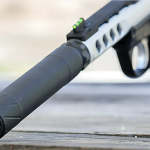Puma AGs third quarter looked a lot like its second quarter, but the Americas and the U.S. in particular strengthened even further as Europe started to show some improvement in both sales and backlog versus the Q2 period. The company reported that consolidated net sales grew 16.6% to 350.5 million in Q3 from 300.6 million in the year-ago period. Worldwide branded sales, including consolidated and license sales, totaled 699 million ($853 mm) in Q3, a 17.7% increase on a currency-neutral basis or 18.4% in Euro terms.
Puma consolidated Europe, Middle East, & Africa into a new EMEA region in the second quarter, which they said was in line with how the market reports. EMEA region sales for Q3 were 345.5 million in Q3, a 5.0% increase versus sales of 329.0 million in the same period last year, and significantly better than the order book that indicated an 8.0% decline in open orders at the start of the third quarter. The region accounted for 66.1% of total consolidated sales versus 71.2% last year. Company chairman and CEO Jochen Zeitz said that France stood out as a positive, while Germany and the U.K. were still at the bottom end of the market.
The EMEA gross margin improved 120 basis points to 54.9% of sales, compared to 52.4% last year, and about even to the Q2 GM line. Order backlog at quarter-end was 510 million ($614 mm), a decline of 4.1% from last year.
Europe benefited from a strong fill-in business in the third period, with at-once orders making up 10% of sale in the region versus its historical level of around 5% of sales. Zeitz said the quarter also got a boost from reduced cancellations and a stronger owned-retail business. He said the European backlog should “turn positive” again by second quarter 2006.
The Americas posted sales of 137.2 million in Q3 versus 83.9 million in Q3 last year and now accounts for 23.8% of consolidated sales versus just 18.2% of total YTD sales at the same time last year. Footwear was said to have “contributed strongly to the overall performance.” Gross margin in the region improved by 90 basis points to 47.7% compared with 46.8% last year.
Backlog in the Americas jumped 72.5% to 225.0 million ($271 mm) from 130.4 million ($157 mm), or a currency-neutral growth of 69.3% at quarter-end. The U.S. order backlog jumped nearly 78.1% to $245 million.
The U.S. market, which is included in the Americas region, posted a 62.7% sales gain in the third quarter, with sales in U.S. Dollars up 62.9% to $131.1 million from $80.5 million in the year-ago period. Mr. Zeitz, when quizzed about the robust rate of growth in the U.S. and how it impacts the brands image that has been built in part through scarcity of product, he explained that the brand is now making its way into the middle of the country from its base of strength on the coasts. He said they will still maintain the scarcity of the product in the mall and the street to keep it special and aspirational.
Zeitz told analysts that bigger accounts will play a larger role in the U.S. next year as it continues regional expansion into the heartland, but he still felt Puma could differentiate the product lines across retailers and channels. He said he expected the double-digit growth in the U.S. to continue through the back half of next year, but the regional expansion through H1 will drive the higher growth rate for the year.
The Asia/Pacific region increased sales 11.7% in Euro terms to 53.6 million from 48.0 million in the year-ago period. Licensed sales for the A/P region were up “significantly” for the period, growing 24.9% to 89 million ($109 mm) in the third quarter. Gross margins improved 320 basis points to 51.8% of sales. Backlog was up 6.0% in Euros to 89 million ($109 mm).
Total company gross margin, while declining for the period on surging U.S. sales, actually got a 90 basis point boost from FX rates and another 40 bps from owned-retail. Those positives were more than offset by about 200 bps attributed to the U.S. margin issues and product mix. Mr. Zeitz said he expected that U.S. margins will continue to be lower and may decline a bit further as the company does more business with larger retailers.
The company continues to draw energy — and nice margins from its owned-retail business. Puma opened four stores during the fourth quarter, including a new store in the Georgetown area of Washington, DC. They now have a total of 57 stores, directly operating 50 of those stores. Five more are planned for the fourth quarter and 10 to 20 additional doors are planned for 2006. Mr. Zeitz said the stores act as an “accelerator” for the brand.
Ownedretail comprised 12.2% of sales, or roughly 65 million ($80 mm), in the third quarter, a 50% increase in revenues from 9.5% of sales, or approximately 44 million ($54 mm) in the year-ago period. Comp store sales were estimated to be up in single-digits. The companys Phase IV plan forecasts owned-retail at 16% to 20% of sales.
Total company order backlog at quarter-end was up 10.1% to 833 million ($1.00 bn), or an increase of 9.5% in currency-neutral terms. By segment, Footwear orders were up 9.7% to 592 million ($713 mm), Apparel orders increased 11.2% to 193 million ($233 mm), and Accessories backlog increased 11.3% to 47 million ($57 mm). Zeitz said he was “quite pleased” with the order intake for the Football (Soccer) category. He sees double-digit growth in the team sports category going forward.
Looking ahead to 2006, Zeitz sees upside potential for the brand at the FIFA World Cup that will be held in the companys home country next summer. He said they already have “at least” nine teams in the World Cup, including four of the five African teams. He said that three more teams could still qualify.
The upside in the U.S. market and continued strength in Asia Pacific led management to increase 2005 full-year guidance. Puma now expects to see net earnings growth in the high-single-digit neighborhood on a double-digit increase in revenues, with EBIT exceeding 20% of sales. Gross margins are now forecast to reach the high end of the range between 51% and 52%, or “slightly above,” offset a bit by higher SG&A expenses associated with a strengthening owned-retail business and start up costs for Phase IV.
| Puma, Inc. | ||||||
| Third Quarter Results | ||||||
| Q3 Group Sales | Backlog Change | |||||
| 2005 | 2004 | Change | Neutral* | Euros | Neutral* | |
| Group Sales | $654.7 | $563.6 | +16.4% | +16.2% | +10.1% | +9.5% |
| EMEA | $421.7 | $402.3 | +5.0% | +4.8% | -4.1% | n/a |
| Americas | $167.5 | $102.6 | +63.5% | +63.2% | +72.5% | +69.3% |
| Asia/Pacific** | $65.4 | $58.7 | +11.7% | +13.2% | +6.0% | +6.0% |
| Footwear | $427.8 | $367.6 | +16.6% | +16.5% | +9.7% | +9.7% |
| Apparel | $182.0 | $158.5 | +15.0% | +14.5% | +11.2% | +10.4% |
| Accessories | $44.9 | $37.5 | +19.9% | +19.6% | +11.3% | +11.6% |
| Net Income | $112.2 | $100.8 | ||||















